Versoix fullcourt
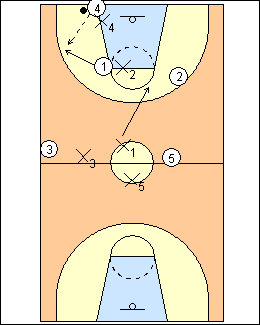 | 1 1) Basic fullcourt pressure This is a conservative fullcourt defence that can be used all game without giving up layups. Defenders do not get in front of their men, inviting over-the-top passes (Avery Johnson - play man-you-basket). They are in intercept not deny positions. No long passes. Converting on a shot, X1 gets back to halfcourt, designated X2 (or X3) goes to the foul line (or above the arc if a shooter), other players can go for an offensive rebound. After a made shot, move up to guard your man as early as possible (X2 guards 1), switch when a cutter uses a screen. X4 jams the inbounder, X2 and X1 have their hands up in a surrender position to avoid fouls, are positioned inside to force a catch towards the corners. Variation - deny the inbounds pass (shoulder-to-shoulder), see the Jim O'Brien white and black match-up. |
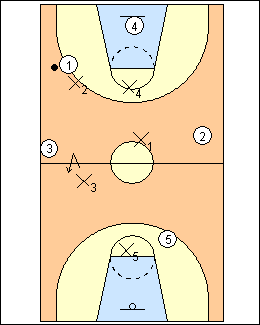 | 2 All defenders get below ball level on the inbounds pass, X4 is the help to contain the ball. Allow ball reversal to the trailer. Shrink the floor with the ball on one side, clog the middle, create a helpside. Pressure but contain the ball, turn the ballhandler in the backcourt, nose on the ball. Off-ball defenders stunt at the dribbler trying to get him out of control or to pick up the dribble. If the on-ball defender gets beat, he sprints to recover, tries to backtip, another defender looks to stunt at the ball and level off the dribbler. Jim O'Brien - as the inbounds pass is in the air, all weakside defenders move to the middle. Maryland - X1, X3 and X5 stay above their men. Kentucky - deny penetrating passes. Billy Tubbs - deny one pass away, including 4. |
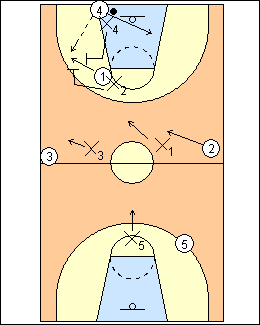 | 3 2) Trap with X4 (one and done) After the inbounds pass X4 gets below ball level and at some point traps the ball. He can trap immediately on the inbounds pass, e.g., to the ballside corner. Avery Johnson - after the inbounds pass, X4 gets to ball level and at some point traps with X1, he can hit immediately on the pass. George Mason fullcourt scramble - X4 is the official trapper, if he thinks he can trap a dribbler before halfcourt, especially secondary ballhandlers. Quick trap option - on an inbounds pass to the short corner. Florida - not many traps against a good team (bad players dribble into traps), but get the ball away from the point guard, make it hard to get back, other players handle the ball. An inbounds pass ballside below the block is an automatic trap by X4. Billy Tubbs - trapping is normally optional but can be required. If you don't trap the inbounds pass they will clear out. |
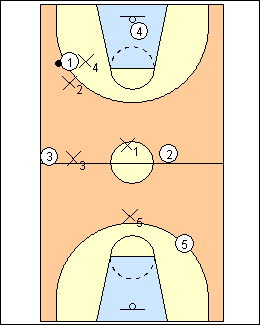 | 4 Basic trap rotation X3 covers strongside 3, X1 and X5 are in help positions. If 1 breaks the trap with the dribble or an advance pass, fullcourt pressure is off, all defenders sprint back to recover, the trappers looks to backtip the ball. (Maryland - don't try to take a dribbler in the middle of the court.). George Mason fullcourt scramble - get "three to the ball" on every trap, the other defenders move in the direction of the ball. Jim O'Brien - rotations after the trap are mostly instinctive, all defenders are below ball level, the only pass not denied is backwards. Hoop Tactics - X3 denies 3, X1 and X5 are in helpside positions. Florida - X1 may be able to steal a pass back to 4, but don't give 2 the middle of the floor. Kentucky - defenders rotate into passing lanes to closest receivers out of the trap but don't allow penetrating passes, X3 takes away the sideline. |
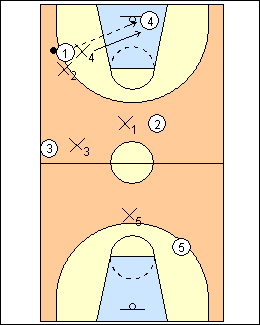 | 5 Trapping is one and done. Ball reversal to the trailer gets the ball away from the point guard, then it's basic fullcourt pressure, X4 recovers to 4 and tries to get him dribbling out of control, or to pick up his dribble. Hoop Tactics - on ball reversal, X1 stunts at 4 until X4 recovers. Florida - X1 does not run up if 4 gets a pass, but will stunt and go back on a shaky big. If the inbounder can handle the ball, trap him; if the big is shaky, they want him to dribble and make a play at speed. Vance Walberg - look to pick off a reversal pass if the trailer leaks up the middle, you can't get to it if he stays way back. |
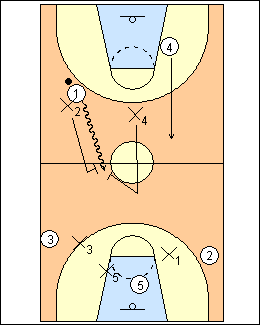 | 6 Instead of hitting immediately, X4 can retreat with the ball and trap on the dribble, e.g., when 1 turns his back, the ball is one step over halfcourt, or on a sideline near halfcourt. Usually funnel trap, with xdribbler forcing middle (or taking away sideline). X4 looks to trap a secondary ballhandler if 1 passes before being trapped. George Mason slow trap - X2 forces 1 to the middle, once 1 dribbles, X2 and X4 herd him until a trap is formed. Avery Johnson - X3 and X1 are the interceptors, but can't get beat backdoor or let the ball go over their heads. X3 tries to deny, X1 plays split between his man and next receiver 4. X5 is the safety protecting the basket, he can't get above 5 or let him run up for an easy catch. Depending on time, score, and spacing, X1 may be able to full rotate for a steal, inviting a pass to furthest attacker 2, X5 may be able to get that pass. Billy Tubbs - a defender trailing the play can go trap near halfcourt, either side of centre. |
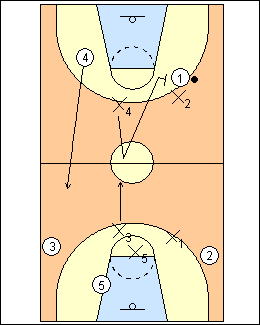 | 7 If inbounder 4 clears out quickly to isolate the ballhandler, X4 can run back to trap when 4 crosses centre. Maryland - the trap guy is the defender of the last attacker to cross halfcourt. If X2 can turn the dribbler so that he turns his back, X4 runs at him to trap. Cover the first two receivers, X5 plays two attackers. If an attacker flashes back to the ball, X5 has to read the trap, if it's good, 1 can't make a long throw, rotate to leave open the furthest person from the ball, but never give up a layup (see man-to-man trap rotation, below). Kentucky - if the ballhandler is isolated in the backcourt on a clear-out, the defender of the last attacker to cross halfcourt goes up to trap, other defenders rotate into passing lanes. Here X3 rotates up on the midline to cover a pass out of the trap to 4, X1 takes away the sideline. The basket protector may have two attackers behind him. Florida - when the ball gets even with the top of the circle, xdribbler stays on the side, another defender runs up to trap, they don't want to allow other teams to just clear them out. Jim Calhoun - it's to the advantage of the defence if 4 has the ball 40 feet from the basket. |
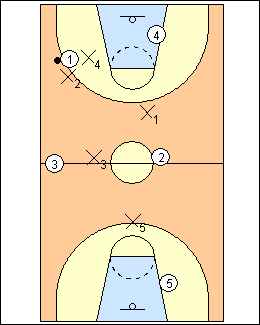 | 8 Other trap rotations a) Zone X1 and X3 cover three attackers, reading 1's shoulders to position themselves, X5 covers deep. Canada Basketball - man-to-man rotation or zoning can be used to defend behind the trap. With zoning, defenders form a 2-1 zone behind the trap, with two interceptors covering three attackers and a safety covering the basket. Jim Calhoun 2-2-1 - protect middle and strongside, leave open a skip pass. Billy Tubbs - trap coverage is sideline, middle and deep, it's a zone once the ball is trapped. X1 has 4 and 2, when in doubt cover the guy who can hurt you the most. If 1 turns his back, X1 can move up towards 4. Bruce Pearl 1-2-1-1 - interceptors X3 and X1 are guarding three attackers, they read the passer to position themselves. If 1 is facing upcourt, shoulders parallel to the baseline, X3 favours sideline, X1 middle; if 1 pivots middle, X3 favours middle and X1 the inbound passer (sometimes they are told not to worry about a pass to 4, but usually they can read and react). X5 looks for a long crosscourt pass but comes up, they never throw long out of a trap. Maryland 1-2-1-1 - X1 has a tough job, can he get to a pass to 4 without giving up a pass to 2? He has to look into the trap. Often X1 moves up to take 4 if 2 goes away from the ball, then 2 is 5's secondary look. The primary look for X3 is sideline, his secondary look is middle. X4 tries to deflect a pass back to 4, all defenders sprint back on a pass to 4. George Mason - X1 and X3 are the interceptors, looking to pick off a reversal or sideline pass. X1 splits 2 and 4, X3 splits 3 and 2. X5 is the goaltender, back with 5. Tubby Smith - if X1 goes up to 4 on the trap, on a pass to 4 then X4 would follow the pass out and take 2 (sprint out, find the open man). If X1 does not go to 4 on the trap, then X4 would go back to 4. |
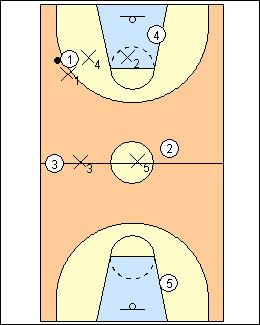 | 9 b) Man-to-man This is an aggressive rotation that may be needed to force a turnover when trailing at the end of a game. On the trap, X2 rotates up to take 4, X5 rotates up to take 2, leaving 5 open. Canada Basketball - with man-to-man rotation, the defender who comes to trap is replaced by the nearest teammate, who is in turn replaced by another defender, leaving open the furthest attacker (or X5 can take a more central position and try to cut off both 2 and 5). Post players can be left out of the rotation. Morgan Wootten - X2 rotates up into the passing lane back to 4, X5 rotates up and plays between 2 and 5, reading the trap. See the John Kimble 1-2-1-1 swarm stunt. |
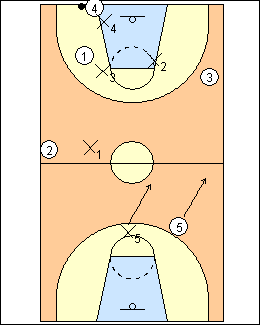 | 10 Match-up options a) White The defence sets up in a 1-2-1-1, each defender matches up with and guards an attacker in his area (back up until you find someone), apply basic or trapping fullcourt pressure. John Kimble 1-2-1-1 match stunt - on a reversal pass to 4 out of a quick trap, X4 takes the trailer, and should be an equal or have a defensive advantage. Also see George Mason Scramble 55. Jim O'Brien white press - deny the inbounds pass, allow only backward passes (the press stays on), force an uncontrolled speed dribble then trap, with back-tipping and levelling off if beaten. Don't trap against good teams, try to get turnovers by forcing speed dribbles. |
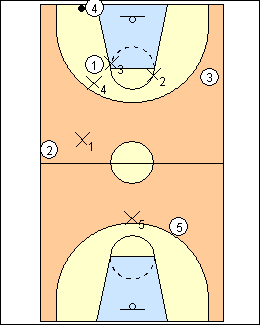 | 11 b) Black Instead of pressuring the inbounder, X4 plays behind the front line of the press, ballside (go with 4 if he runs the baseline), and matches up with 4. See Jim O'Brien black press (there is no quick trap on an inbounds pass to the ballside corner). |
This page was made with Basketball playbook from Jes-Soft